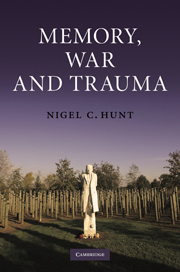Book contents
- Frontmatter
- Contents
- Preface
- 1 Background and purpose
- 2 Historical perspective
- 3 Methods and ethics
- 4 Current theory: post-traumatic stress disorder
- 5 Approaches to understanding trauma
- 6 Positive outcomes of traumatic experiences
- 7 Memory and history
- 8 Personal narrative and social discourse
- 9 Illustrating narrative as a scientific technique: the role of social support
- 10 Ageing, trauma and memory
- 11 Literature and trauma
- 12 Memorialisation and commemoration
- 13 Battlefield tours
- 14 Conclusions and future directions
- References
- Index
12 - Memorialisation and commemoration
Published online by Cambridge University Press: 05 June 2012
- Frontmatter
- Contents
- Preface
- 1 Background and purpose
- 2 Historical perspective
- 3 Methods and ethics
- 4 Current theory: post-traumatic stress disorder
- 5 Approaches to understanding trauma
- 6 Positive outcomes of traumatic experiences
- 7 Memory and history
- 8 Personal narrative and social discourse
- 9 Illustrating narrative as a scientific technique: the role of social support
- 10 Ageing, trauma and memory
- 11 Literature and trauma
- 12 Memorialisation and commemoration
- 13 Battlefield tours
- 14 Conclusions and future directions
- References
- Index
Summary
The purpose of this chapter is to show how memory, narratives, social discourse and history are interlinked via the remembrance of war, and how people have a psychological need and a social duty to remember those who died in past wars.
Societies have always used memorials to help them to remember past events or people. Commemoration is probably the most heavily trafficked point of intersection between history, sociology and political science (Wilson, 2005) and the place of commemoration in the construction of group, particularly national identities. Psychology also has an important role to play here, as it is concerned with the role of individual memory and how the individual fits within the social context of such events. Memorials can be instituted by the state or by private individuals; they can be public or private (e.g. Quinlan, 2005b). British war graves, instituted in their present form after the First World War, are uniform except for the message at the base, where families are permitted to add a short message (even these employ a common social discourse, with the same phrases occurring repeatedly). The graves are institutional and public. In old battlefields such as the Somme, new memorials, privately funded but in public positions, are still being erected, long after the participants in the event are dead. These are attempts to ensure that the memories of particular individuals or groups are remembered by later generations, perhaps with the fear that they are being forgotten?
- Type
- Chapter
- Information
- Memory, War and Trauma , pp. 172 - 185Publisher: Cambridge University PressPrint publication year: 2010



